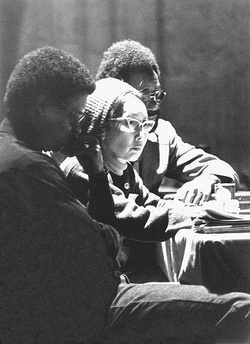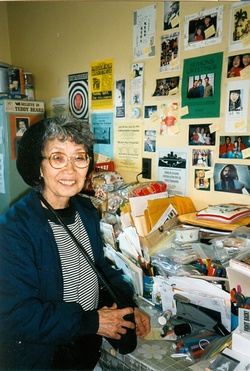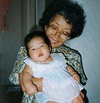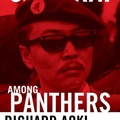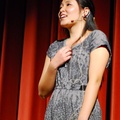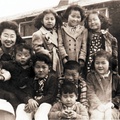Read Part 2 >>
In December 1960, looking for a bigger home for their six kids, Yuri and Bill moved their family out to a new housing project in Harlem, New York, the epicenter of the newly emerging Civil Rights Movement.
As Yuri expressed in the documentary, Passion for Justice, “the Movement is contagious and awesome because the people in it are the spirit of the Movement,” (Yuri Kochiyama: Passion for Justice, 2005) she slowly immersed herself into the movement as she increased her awareness of the struggles of people surrounding her.
She became involved in a variety of organizations that dealt with a diverse array of social issues that ranged from equal job and housing opportunities; the Harlem Parents Committee, “a grassroots movement to get safer streets and integrated education in the Harlem community” (Kochiyama 2004, 48); and CORE whose purpose was to eliminate racial discrimination by non-violent demonstration.
The most influential political figure in Yuri’s life was Malcolm X. He truly turned her world upside down. During this period, there were two main prospects that people were fighting for, integration led by Martin Luther King Jr. and Black Nationalism led by Malcolm X.
Malcolm X believed in self-determination and self-defense because there could not be integration in such a racist society. He also believed that black people should not assimilate to become like the white people in power who were oppressing them.
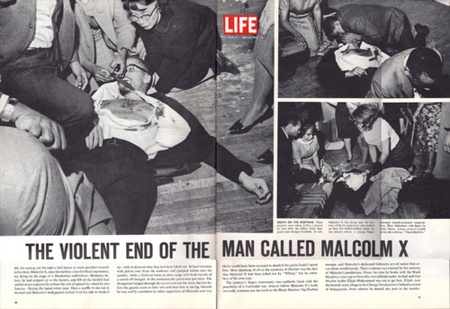
Life Magazine's article "Death of Malcolm X" on March 5, 1965. On the left page, you can see Grandma Yuri holding Malcolm X's head at the top.
At the time, Yuri believed in integration, but upon meeting and hearing Malcolm speak, he made her question her views. In a speech, she reflected on Malcolm: “Malcolm used to always reiterate study history and learn about ourselves and others. There is more commonality in all of our lives than we think. It will help us understand one another. Knowledge of history can be used as a weapon to divide us further or seek truth and learn from past errors and flagrant remisses. Our ultimate objective in learning about anything is to try to create and develop a more just society than we have seen.” (Yuri Kochiyama: Passion for Justice, 2005).
Near the end of the ’60s, she became more involved with Black movement, becoming a citizen of the Republic of New Africa and also was a member of the Puerto Rican Young Lords Party, where she participated in the takeover of the Statue of Liberty to grab the attention of the media in hopes of freeing four Puerto Rican political prisoners, in which they were successful.
It wasn’t until 1969, that AAA (Asian Americans for Action) was established. This was the first Pan-Asian community organization in New York that was initially intended to be a social, cultural organization, but became a political one.
Within this organization, Yuri marched in protests and spoke at rallies against the Vietnam War, for which she tied the U.S.’s imperialism on people of the Third World to the racism that white American society was exhibiting on Harlem.
In a broader context, “the Antiwar Movement was no longer focused solely on saving American lives; it was also about ending imperialism and racism in the United States and abroad” (Fujino 2005, 236). Besides the antiwar campaign, AAA grew to acknowledge and fight for better healthcare, jobs and housing issues dealing with racism, and issues that were political, social, and cultural, where Yuri became a mentor and leader because of her status and experience in the Black Movement. They held educational forums and organized demonstrations to relay to their messages.
“AAA as well as the emerging Asian American Movement gave Yuri an opportunity to work on issues affecting Japanese and Asian Americans and to make linkages between Asian and Black issues” (Fujino 2005, 238).
One of their main focuses was on the American educational system and how its disparity between the rich and poor or White America and ethnic minorities was growing. In order to help bridge this gap and increase awareness, AAA fought for an ethnic studies program to include the histories of these underrepresented minorities. When successful, but not yet fully equipped with a qualified teaching staff, they asked Yuri to temporarily teach a class called “Social Science Approach to Asia.”
The Redress movement was finally set into motion in 1970 after individual proposals for redress, starting from the late 1940s, were finally heard.
In response to the Iranian student organized seizure of the U.S. embassy in Tehran that spread fears that the government was considering the possibility of incarcerating Iranians in the U.S., Yuri and Bill along with others formed CJA (Concerned Japanese Americans), who teamed up with Iranian American students to hold awareness panels and demonstrations to prevent the injustice that the Japanese Americans had faced in World War II from happening to Iranian Americans in 1980.
CJA was also involved in the push for congressional hearings in New York. In 1980, Congress established the CWRIC (Commission on Wartime Relocation and Internment of Civilians) to further investigate whether an injustice had occurred when Roosevelt signed Executive Order 9066 and the appropriate compensation for its victims, which held a series of hearings on the east and west coasts, where Japanese internees, including my grandfather, Bill, talked about their experiences.
In lecture, Professor Omi compared the incarcerated Japanese to a rape victim in the feelings of guilt and shame possessed from thinking that maybe they had been at fault for this injustice that occurred and also from the painful emotional scars they nursed. Both parties harbored and locked these feelings within them, which was why much of the Issei generation chose to remain silent. It was not until the Nisei generation, that their voices were finally heard.
Two years after the hearings the CWIRC presented their reports to Congress, concluding that the cause of incarceration was indeed unjustifiable by militant necessity. The real causes were, Professor Omi, an Asian American Studies Professor at UC Berkeley, stated, “race prejudice, war hysteria, and a failure of political leadership.”
Although the material losses of Japanese Americans were great in their property, prospective income, and interrupted dreams, it was not possible to calculate the compensation for human capital, their psychological pain. With the combined effort of the JACL (Japanese American Citizens League), NCJAR (National Council for Japanese American Redress), and the NCRR (National Coalition for Redress/Reparations), the Civil Liberties Act was passed and signed by President Ronald Reagan on August 10, 1988. This bill granted Japanese American internees a public apology on behalf of the president and $20,000 for each living survivor, a great triumph for Japanese Americans.
Even into her 80s, although she had slowed down quite a bit, Yuri still remained amazingly active giving interviews, speaking at events, and mailing tons of letters daily to political prisoners, family, and friends always kept us updated with the current news and progress with her projects.
In her speeches, she encouraged and excited the younger generations to become more socially politically aware and become involved in the constant struggle for a better society. Moreover, my grandma’s actions and activism know no boundaries or color lines. She “has always worked as an ally in various communities, ones beyond her own identity as a Japanese American/Asian American woman. And truly, that is what mixed-race America is all about—going beyond your own interests and understanding the way that we are all mixed here together—someone else's injustice is OUR injustice.” (Jennifer, 2008) She has united communities and organizations through her passion for justice and made people realize that many others struggle with common issues and in this fight, where unity is strength.
It always amazes me that this astonishing woman is actually my grandma, the woman who has inspired so many people by her accomplishments, but most of all, her unrelenting audacity and passion. She is so powerful, smart, passionate, as much as she is humble, generous, and encouraging. I am honored to be her granddaughter.
I want to conclude this paper with one of her quotes, though concise, speaks volumes. In the television series documentary, Cool Women, an interviewer asked her what she wanted to pass on as her legacy and she simply said, “Build bridges, not walls.” (Cool Women, 2000)
Bibliography
Cool Women: Yuri Kochiyama; Manuela Carrasco. Allen, Debbie and Jeff Eisenberg. 14 Sep 2000.
Fujino, Diane C. Heartbeat of Struggle: The Revolutionary Life of Yuri Kochiyama. Minneapolis: University of Minnesota Press, 2005.
Jennifer, “Spotlight on Yuri Kochiyama—Asian American activist.” Mixed Race America. 14 May 2008. 30 Nov 2010 (http://mixedraceamerica.blogspot.com/2008/05/spotlight-on-yuri-kochiyama-asian.html ).
Kochiyama, Yuri. Passing It On: A Memoir. Los Angeles, CA: UCLA Asian American Studies Center Press, 2004.
Yuri Kochiyama: Passion for Justice. Videocassette. Saunders, Pat and Rea Tajiri. San Franciso, CA: NAATA/ CrossCurrent Media, 1995.
* * *
Maya Kochiyama also compiled an album with photos about her continuous journey to discover the legacy of her grandma in the Nikkei Album. Please check it out!
My Journey to Discover the Legacy of my Grandma, Yuri Kochiyama >>
© 2011 Maya Kochiyama


